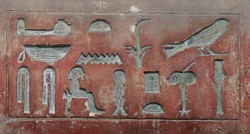By Rhio Barnhart. Published on Egyptological, In Brief, June 29th 2011.
In 2009 I signed up to study the ancient Egyptian Language online through the Glyphstudy group: http://groups.yahoo.com/group/GlyphStudy.
The Glyphstudy group is available, free of charge, to anyone interested in studying the grammar of ancient Egyptian. There are a number of groups under the Glyphstudy banner. Since not everyone will want to undertake a full grammar, there are a couple of less intensive texts available for those interested in a gentler introduction. For those students I would recommend the Glyphstudy group using the Janice Kamrin’s Ancient Egyptian Hieroglyphs, A Practical Guide. For those who want a full course, two full grammars are currently used. The text I chose is James Hoch’s Middle Egyptian Grammar.
Undertaking this study is ultimately very satisfying. However, regardless of the level of text selected, it is extremely challenging. The language existed for some 4,500 years and underwent considerable changes over its long history. “Middle” Egyptian is the version in use from ca. 2135 – 1300 B.C.E., or Dynasties 9-18. Although there were two principle scripts used for Middle Egyptian, hieroglyphic and hieratic, it is hieroglyphic script that is used in the initial study.
The student initially learns the 27 signs that comprise the “alphabet”. Besides depicting various objects, these signs also have a phonetic value. One learns the signs, the phonetic value as well as the corresponding traditional transliteration symbols. A parallel set of transliteration symbols, the Manuel de Codage (http://en.wikipedia.org/wiki/Manuel_de_Codage), using standard alphabet symbols is also learned for submitting excercises online. Hoch next covers Egyptian sentence structure. Word order in Egyptian is very fixed and one must have a good understanding of this to learn the way the language is put together. Next the student is introduced to nouns, adjectives and pronouns.
Hoch introduces verbs early on in chapter three, but gently. The Egyptian verbal system comprises the bulk of the 16 lessons and can be daunting. Barbara Mertz says that when one begins to study verbs, “the casualties begin”. Hoch keeps his grammar concise; the 16 lessons comprise only some 234 pages. There is a dictionary of vocabulary and a key to the excercises. Hoch wrote his text book to be used in his classes and his explanations are sometimes not as fully fleshed out as in other texts. The moderator of the group provides a study guide to supplement each lesson that can be downloaded and printed. They are superb and enormously helpful.
If one can afford it, it is extremely helpful to acquire the other two major grammars, Alan Gardiner’s Egyptian Grammar and James Allen’s Middle Egyptian, both of which are available for purchase online. Especially in the more advanced areas, these texts all complement each other and comparison becomes extremely valuable in establishing a comprehensive understanding.
There are many online resources to assist with the study of Egyptian.
It is difficult to retain all the points of grammar and learn vocabulary. It is also one of the most fascinating things you will ever do and will enrich your life in ways you cannot imagine. It helps with an in-depth understanding of this amazing ancient civilization and its history.
The Glyphstudy calendar is designed to be of manageable length and sufficient time is provided to learn difficult material. The Hoch group has taken about two years to complete. After completion you will have an excellent knowledge, equivalent to a college course, of the fundamentals of an extremely difficult ancient language.
Biography

 By
By